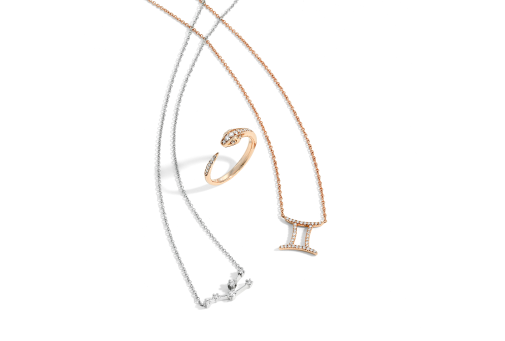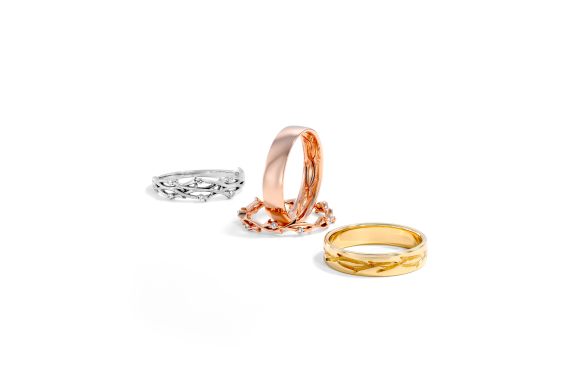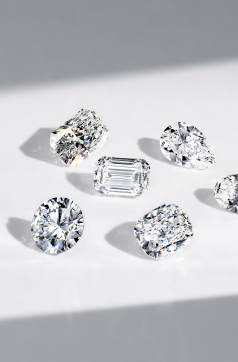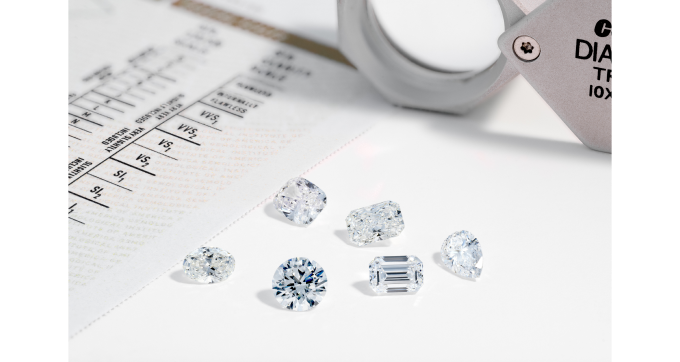Quick Summary
Diamond cutting has transformed over the centuries, resulting in diamond cuts that don't exist any more. Historic cuts such as the Portuguese, point, rose, table, and briolette each had their moment but eventually faded due to limited brilliance or practicality. These antique cuts still inspire today’s most loved shapes, keeping their spirit alive in more radiant and durable designs. The round brilliant, marquise, oval, emerald, and pear cuts reflect this evolution, blending timeless charm with dazzling performance. Keyzar highlights these modern cuts through vintage-inspired engagement rings. With intricate details, virtual try-on tools, and a balance of heritage and sparkle, Keyzar makes it easy to find a ring that feels both romantic and enduring.
Diamonds have always captured attention, but the way they’re cut has changed dramatically over the centuries. Early designs were simple, geometric, and far less sparkly than what we see today. As cutters refined their skills and techniques, diamonds began to radiate with brilliance, fire, and elegance, turning them into dazzling symbols of love and artistry. Each era left its mark, giving us fascinating shapes that tell a story of history, style, and innovation.
But with progress comes change, and some cuts have slipped quietly into the past. Shapes like the point cut, rose cut, and briolette once had their shining moment, yet are now rarely seen outside of antique collections. In this blog, we’ll look at these historic diamond cuts that don’t exist any more, explore why they faded, and show you the modern shapes that capture the same timeless spirit in dazzling new ways.
Historic Diamond Cuts That Have Faded Away
Diamond cutting began with shapes that were far simpler than the brilliant styles we know now. Early cuts were more about enhancing a rough stone’s natural form than maximizing sparkle. These designs marked important steps in history, yet they eventually faded as jewelers discovered ways to unlock greater light and brilliance.
The Portuguese Cut
Introduced in the early 20th century, the Portuguese cut quickly became admired for its striking complexity and luminous fire. With up to 161 facets arranged in layered patterns, it produced a brilliance that few cuts of its era could rival. This spectacular play of light made it a favorite among collectors who craved diamonds with dramatic presence. Yet the very qualities that made it so breathtaking also limited its staying power, as the intricate faceting required exceptional skill and sacrificed much of the rough stone. Today, the Portuguese cut survives as a rare and cherished gem, most often seen in antique treasures or commissioned custom designs that honor its legacy.
The Point Cut
The point cut can be traced back to the Middle Ages. It was created by polishing a natural octahedron into a pyramid shape, leaving the gem with a sharp tip that resembled a tiny mountain peak. While it carried historical charm, the cut offered very little sparkle and was prone to chipping at the fragile point. As diamond cutting advanced, jewelers turned toward faceted designs that could better capture light and withstand everyday wear, leaving the point cut as a fascinating but largely forgotten relic of diamond history.
The Rose Cut
The rose cut was especially prominent during the Georgian and Victorian eras. With a flat base and a domed crown covered in triangular facets, it was designed to resemble the petals of a blooming rose. This cut produced a soft, romantic glow that looked especially enchanting in candlelight. However, as tastes shifted toward diamonds with greater fire and sparkle, the rose cut faded from mainstream use, leaving behind a legacy that still charms collectors of antique jewelry today.
The Table Cut
Emerging in the 15th century, the table cut was one of the first attempts at adding facets to a diamond. Its design featured a square or rectangular outline with a large flat surface on top, giving the stone a simple, geometric look. While it marked a step forward from the uncut or point styles, the table cut offered limited brilliance and felt restrained compared to later innovations. Over time, it was replaced by step cuts like the emerald, which carried its clean lines while offering more durability and visual appeal.
The Briolette
The briolette gained popularity in the 17th through 19th centuries, particularly for pendants and earrings that showcased its graceful teardrop shape. Unlike most cuts, it had no table or pavilion, instead covered entirely in tiny facets that created a delicate shimmer. While beautiful in movement, its fragile structure made it impractical for rings and everyday wear. Over time, jewelers gravitated toward sturdier shapes with greater brilliance, leaving the briolette as a romantic cut most often admired in antique pieces.
Modern Alternatives That Capture the Same Spirit
While some diamond cuts have faded into history, their influence shines brightly in the shapes we adore today. From refined marquise silhouettes to glowing ovals and timeless round brilliants, modern diamonds let you enjoy the beauty of the past while sparkling with all the brilliance of contemporary craftsmanship.
Round: The Brilliant Successor to the Portuguese Cut
Perfected in the early 20th century, the round brilliant quickly became the most popular diamond cut. With 57–58 facets, it maximizes light return and delivers fire that suits every setting, from simple solitaires to dazzling halos. Its timeless proportions give it universal appeal, making it the cut of choice for brides who want radiant beauty with a classic feel. The Charlotte captures this brilliance beautifully with its vintage-inspired bezel setting, pavé accents, and a design that blends everyday wearability with glamorous detail.
Marquise: The Refined Successor to the Point Cut
The marquise cut carries forward the dramatic outline of the historic point cut while adding brilliance and sophistication through its 58 facets. Its elongated shape with pointed ends creates a striking presence on the hand, making fingers appear longer and more graceful. This bold silhouette appeals to those who want elegance with a touch of drama. The Amber highlights this charm with ornate detailing, delicate engraving, and a smooth solitaire band that balances vintage artistry with modern comfort.
Oval: The Romantic Alternative to the Rose Cut
The oval cut echoes the soft curves and vintage charm of the rose cut while adding the brilliance that modern brides adore. Its elongated shape is versatile, looking radiant in solitaire styles and breathtaking in more elaborate settings. With its blend of style and sparkle, the oval appeals to those who love antique-inspired romance paired with modern performance. The Jasmine embodies this spirit with its Art Deco design, milgrain accents, and a graceful band lined with diamond-accented oval and round frames.
Pear: A Modern Echo of the Briolette
The pear cut carries forward the graceful teardrop silhouette of the briolette while adding the brilliance and durability that antique styles lacked. Its blend of round and marquise elements gives it both sparkle and distinction, making it versatile for solitaires, halos, or bridal stacks. Brides who love romance with a touch of drama are drawn to its striking outline and luminous fire. The Stephanie reflects this beauty with intricate milgrain flourishes, a high profile, and a vintage-inspired design that enhances any center stone with timeless charm.
Emerald: A Contemporary Take on the Table Cut
The emerald cut builds on the simplicity of the historic table cut, transforming it into a style with sophistication and balance. Its clean lines and step facets create a graceful hall-of-mirrors effect, giving the diamond depth and grace rather than fiery sparkle. Brides who admire architectural beauty and timeless design are drawn to this cut for its refined presence. The Elizabeth captures that vintage charm with engraved vine patterns, delicate accents, and a slender band that elongates the hand with understated style.
Keyzar Jewelry Embraces Modern Cuts with Vintage Style
At Keyzar, many of the designs in our engagement ring collection highlight vintage-inspired artistry. From milgrain detailing to sculpted bands and ornate patterns, Keyzar’s engagement rings echo the romance of the past while still offering the sparkle and strength today’s couples expect.
Exploring these rings is made effortless with Keyzar’s virtual try-on tools and 360° diamond views. You can see how vintage-inspired cuts and settings capture light from every angle, compare styles side by side, and find the one that looks the most enchanting on your hand. With this combination of old-world charm and modern design, Keyzar ensures each engagement ring feels timeless, glamorous, and made to be treasured.
Conclusion
Diamond cutting has always reflected both artistry and innovation. While historic cuts like the rose and point have faded from everyday use, their influence continues in today’s ovals, marquises, pears, and emeralds.
If you’re drawn to the elegance of antique styles but want the sparkle and strength of contemporary design, modern diamond cuts deliver both. Keyzar Jewelry’s collection makes it easy to explore these options and find a diamond that feels connected to history while shining brilliantly into your future. Shop now!






